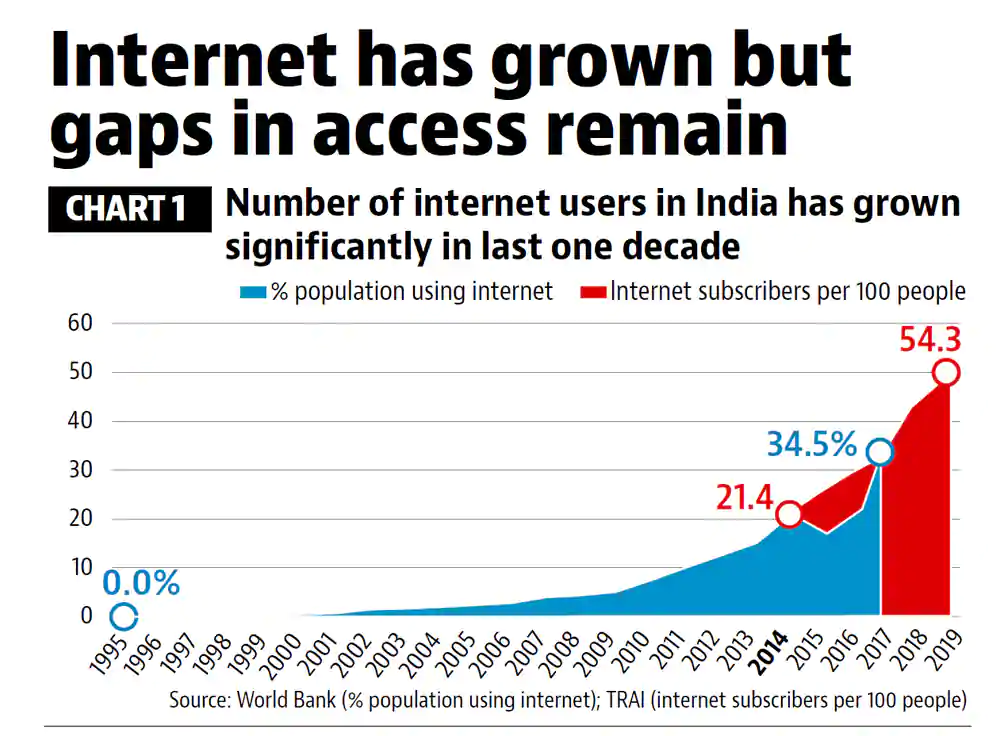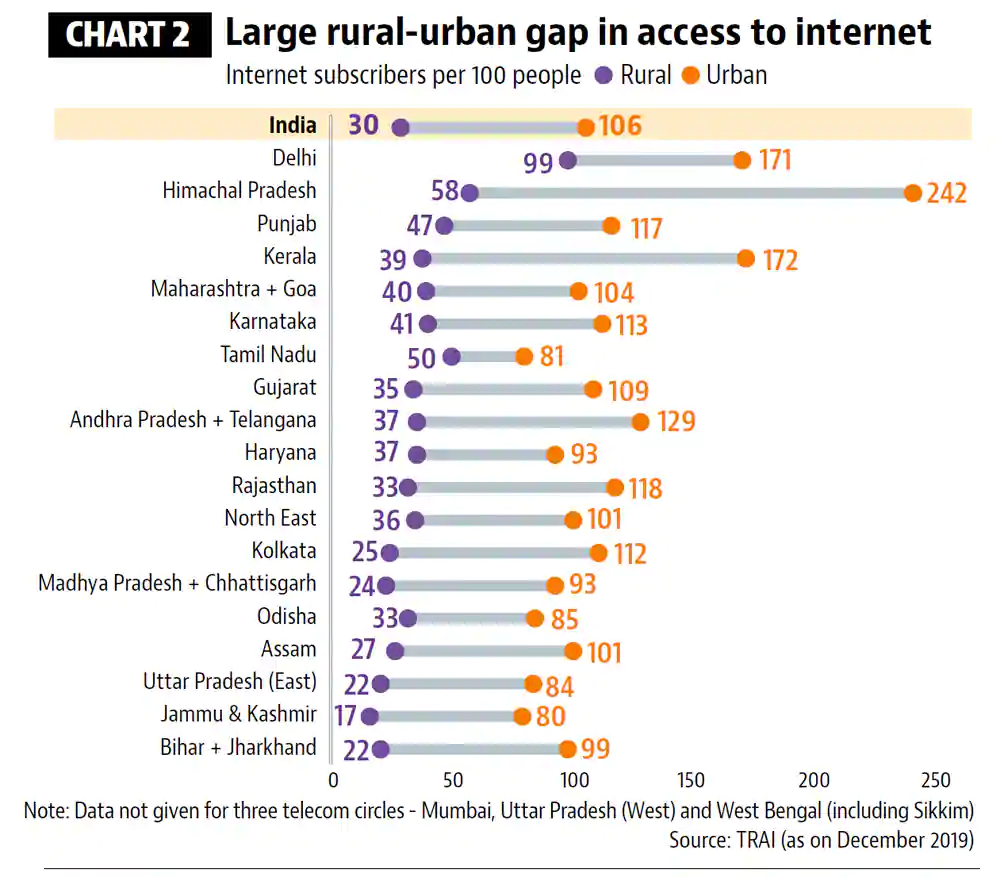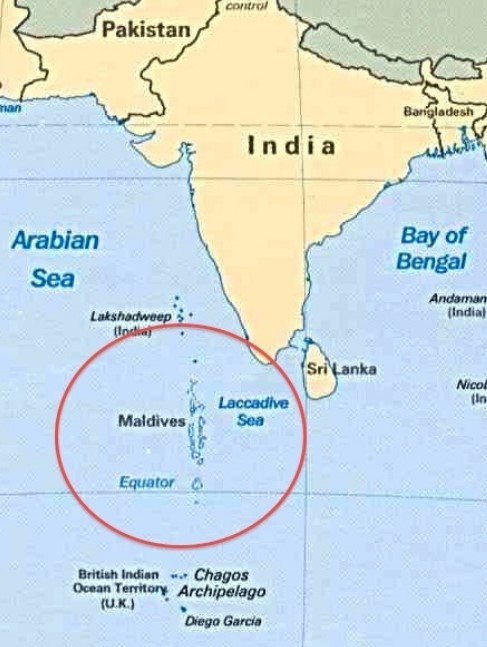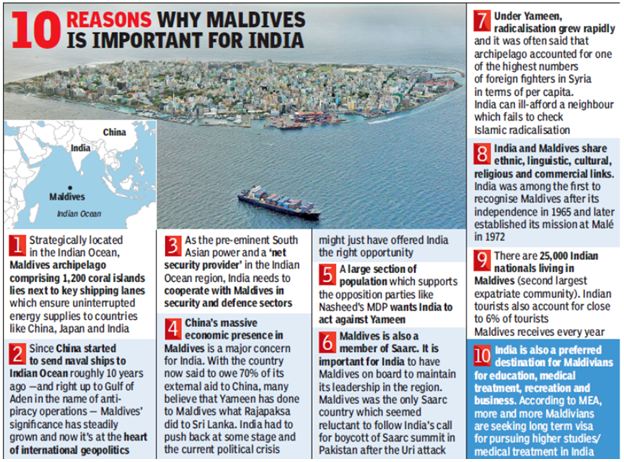Contents
- Internet Connectivity Improves but Gaps remain
- Retail inflation accelerates to 6.93% in July
- NHRC members flag lack of forensic labs
- India announces $500 mn package for Maldives
- India, Australia share views on 5G
INTERNET CONNECTIVITY IMPROVES BUT GAPS REMAIN
Focus: GS-III Science and Technology, Industry and Infrastructure
Introduction to internet in India
- The internet was first used in India in 1980s, but was available to a limited educational and research community.
- It was thrown open to public use for the first time on India’s 49th Independence Day in 1995.
- Internet is now at the core of the communication network – there are more than 700 million internet subscribers in India – but there is still a significant population not connected to the internet.
Details
- The number of internet users in India has grown significantly in recent years, according to data compiled by the World Bank.
- It was almost seven years after the internet was first thrown open to the public that more than 1% of India’s population used the internet.
- But then, in just six years, the share of the population using the internet grew by almost 25 percentage points – to 34% in 2017.
To contrast – Globally, 50% people used the internet in 2017, and the figure is much higher in developed countries – 87%.
Post 2017
- Telecom Regulatory Authority of India (TRAI) shows that the internet has penetrated even deeper into the society after 2017.
- Internet subscribers per 100 people in India has grown by 20 percentage points in just two years since 2017.

Primary Reason
- Mobile telecom networks have played an important role in increasing internet access in India.
- 3G internet service was first launched in 2008 and 4G in 2012, and after this between 2013 and 2019, there was a 68% increase in the number of wireless internet users.
Other side of the coin
- Even as the number of internet users has been growing rapidly, there is still a large population with no access to the internet – particularly in rural areas, poorer states and in poorer households.
- The Delhi telecom circle, Himachal Pradesh and Punjab service areas are in the top 3 in terms of the number of internet subscribers per 100 people.
- There are less than 50 internet subscribers per 100 people in at least six telecom circles – comprising of states such as Jharkhand, Bihar, Jammu & Kashmir, Assam etc.
- In urban areas, there are more than 100 internet subscribers per 100 people (as in one person has more than 1 connection, so the number is greater than population) in 12 telecom circles, but in rural areas, this figure is less than 60 in all circles except the rural parts of Delhi.
- Internet usage also varies significantly with class and gender.
- National Statistical Office survey on consumption of education services in India shows that nearly 24% households in the country had access to the internet in 2017-18 and this figure increased with increasing monthly per capita expenditure of households.
- Another survey finding shows that 40% people in the age group of 15 to 29 years were able to use the internet, but this figure was 48% among men and 32% among women, a gap of 16 percentage points.

-Source: Hindustan Times
RETAIL INFLATION ACCELERATES TO 6.93% IN JULY
Focus: GS-III Indian Economy
Why in news?
India’s retail inflation accelerated to 6.93% in July from 6.23% in the preceding month, dimming chances of further policy rate cuts by the Monetary Policy Committee of the Reserve Bank of India any time soon.
Details
- Data released by the National Statistical Office showed food inflation again picked up in July after decelerating in June – mostly due to localized lockdowns across the country and heavy monsoon rainfall in parts of the country.
- Inflation in rural India remained higher compared to urban India – due to supply disruptions leading to elevated food prices.
- Among states and union territories, Assam faced highest retail inflation while Delhi saw the lowest inflation.
- Inflation increase of some of these commodities at a time of depressed demand is perplexing, which suggests the inflation increase is mainly due to supply disruption not due to demand pressure.
- Also, the government policy of not reducing the price of petrol and diesel has kept the transport costs higher.
How does this pan out for RBI’s decisions?
- While retail inflation continues to exceed the upper range (6%) of the central bank’s tolerance level, the severe economic slump is expected to keep monetary policy accommodative in the foreseeable future.
- RBI’s Survey of Professional Forecasters on Macroeconomic Indicators showed GDP may contract 21.5% in June quarter and 5.8% in FY21.
- Experts suggest that the retail inflation may remain appreciably above 6% in August.
- Monetary policy was already in an accommodative mode before the outbreak of covid, with a cumulative policy rate cut of 135 basis points between February 2019 and the onset of the pandemic.
- While holding the policy rate unchanged, RBI hoped a more favourable food inflation outlook may emerge as the bumper rabi harvest eases prices of cereals, especially if open market sales and public distribution offtake are expanded on the back of significantly higher procurement.
- Households’ one year ahead inflation expectations were lower than their three months ahead expectations in the July 2020 round of the RBI’s survey, indicating their anticipation of lower inflation over the longer horizon.
Click Here to read more about RBI’s Position on keeping the rates unchanged
-Source: Livemint
NHRC MEMBERS FLAG LACK OF FORENSIC LABS
Focus: GS-III Science and Technology
Why in news?
Members of the National Human Rights Commission have raised concerns over the inadequate number of forensic science laboratories in the country that delays evidence gathering, leading to cases pending in courts and undertrial prisoners remaining behind bars.
Details
- If forensic evidence was collected and preserved on time, particularly in sexual assault cases, the case could be resolved sooner.
- The experts informed the officials that 70% of the weapons used in the country are “country-made” and do not comply with specifications that can be traced.
- The Centre had allocated ₹200 crore out of the Nirbhaya Fund to States to ramp up forensic science infrastructure.
- The NHRC would follow up on the matter, seeking action-taken reports as needed.
Nirbhaya fund
- Nirbhaya fund was created in 2013 in the aftermath of December 2012 Delhi gangrape and murder case.
- Giving in to popular sentiments, the government announced a separate fund for meeting expenditures to ensure the safety of women.
- The government proposed an allocation of Rs 10,000 crore under the Nirbhaya Fund to ensure the safety of women.
- Under the Nirbhaya Fund, the Centre gives money to the states, which in turn spend it on programmes meant for ensuring women’s safety.
- The Women and Child Development Ministry is the nodal agency for expenditure from the Nirbhaya Fund.
- The ministry it examines the programmes submitted to it by the states under the Nirbhaya scheme, approves them and recommends to the Department of Economic affairs for allocating funds.
- The Nirbhaya Fund Framework provides for a non-lapsable corpus fund for the safety and security of women to be administered by the Department of Economic Affairs (DEA) of the Ministry of Finance (MoF) of the Government of India.
- Further, it provides for an Empowered Committee (EC) of officers chaired by the Secretary, Ministry of Women & Child Development (MWCD) to appraise and recommend proposals to be funded under this framework.
The below standard funding pattern will be followed:
- 60:40 for all States normally
- 90:10 for States with difficult terrains
- 100% for UTs
- Few initiatives are 100% funded
-Source: The Hindu
INDIA ANNOUNCES $500 MN PACKAGE FOR MALDIVES
Focus: GS-II International Relations
Why in news?
India announced a slew of new connectivity measures for the Maldives, including air, sea, intra-island and telecommunications in an effort to help the Indian Ocean Islands deal with the economic impact of the COVID-19 pandemic.
Details
- Among the initiatives announced at a meeting between Indian External Affairs Minister and Maldives Foreign Minister are an air connectivity “bubble” for travel, a direct ferry service, a submarine cable for telecom connectivity; and assistance for the Greater Male Connectivity project (GMCP) to connect Male to three neighbouring islands, the biggest such project thus far.
- India has decided to support the implementation of the GMCP in Maldives, through a financial package consisting of a grant of USD 100 million and a new Line of Credit (LoC) of USD 400 million.
- The US $400 million Line of Credit comes in addition to a previous LoC of $800 million that was announced by New Delhi in 2018.
- The GMCP would be the largest civilian infrastructure project in Maldives.
Connecting islands
- The project, which will consist of a number of bridges and causeways to connect Male to Villingili, Thilafushi and Gulhifahu islands that span 6.7 km, taking much of the pressure of the main capital island of Male for commercial and residential purposes.
- When completed, the project would render the Chinese built Sinemale Friendship bridge connecting Male to two other islands quite insignificant in comparison.
India–Maldives relations

- India and Maldives are neighbors sharing a maritime border and relations between the two countries have been friendly and close in strategic, economic and military cooperation.
- Maldives is located south of India’s Lakshadweep Islands in the Indian Ocean.
- Both nations established diplomatic relations after the independence of Maldives from British rule in 1966.
- India has supported Maldives’ policy of keeping regional issues and struggles away from itself, and the latter has seen friendship with India as a source of aid as well as a counterbalance to Sri Lanka, which is in proximity to the island nation and its largest trading partner.
Significance
- Maldives plays an integral role in realising the potential of Indian Ocean blue economy as a contributor to the security and sustainable development of sea resources.
- The growing Chinese presence in the archipelago could have serious security implications.
- The crucial oil supply coming from Gulf nations to India pass through this area.
- There are about 25,000 Indian expatriates in Maldives who are engaged in a number of professional pursuits and their security is also of prime concern for India.

-Source: The Hindu
INDIA, AUSTRALIA SHARE VIEWS ON 5G
Focus: GS-II International Relations
Why in news?
India and Australia are sharing experiences on protecting critical infrastructure, including 5G networks, said a senior Australian High Commission official while talking of the huge increase in cybersecurity cooperation between the two countries, however, clarifying that Australia has no intention of banning Chinese apps like India has done.
Details
- At the Prime Minister’s virtual summit India and Australia had signed a cyber and cyber-enabled critical technology framework agreement along with the Comprehensive Strategic Partnership (CSP).
- India and Australia have a close and ongoing dialogue and exchange a range of experiences, including what is being done regarding critical infrastructure and aspects, including our 5G network, and how to police the dark web.
- In August 2018, Australia had banned Chinese companies from offering 5G services, citing national security.
- India banned 59 Chinese apps citing national security and later banned 47 more Chinese apps.
Categories of threats
The two diplomats said the categories of threats that the two countries were looking at were criminal groups, financial gain, sophisticated state-based actors, terrorist groups, issues-based groups which might use the Internet to motivate, and countering terrorism including violent extremism.
5G Club
- Britain said that it was pushing the U.S. to form a club of 10 nations that could develop its own 5G technology and reduce dependence on Huawei.
- Proposed D10 club of democratic partners includes G7 countries – UK, US, Italy, Germany, France, Japan and Canada – plus Australia, South Korea and India.
- It will aim to create alternative suppliers of 5G equipment and other technologies to avoid relying on China.
- It can be seen as a means to ensure that these new entrants belong to like-minded democratic regimes, thus alleviating any security concerns.
- This move will also allow more 5G equipment and technology providers to come up.
- It basically addresses the raised concerns regarding potential surveillance and breach of their national security by China using the state-run Huawei.
5G and India’s Potential
- India’s is the second biggest smartphone market in the world, leading to an exponential rise of data consumption – India consumes more than 11 GB/user/month — the highest in the world.
- There is no practical way in which fiber net connectivity can be enhanced quickly in India which poses a serious challenge to back-haul capacities of the macro towers.
- The Fourth Industrial Revolution (aka Industry 4.0) is powered by emerging technologies like artificial intelligence, machine learning, Internet of Things, Edge Computing, which need 5G to be effective. This will also raise additional revenue streams for the network carriers which are already stressed with financial burdens.
- It will also help with India’s Smart Cities Mission as 5G powers the technology driving smart cities.
-Source: The Hindu





